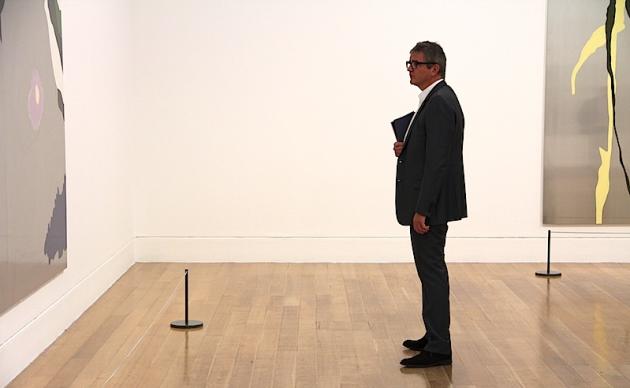The parallel retrospective exhibitions of two prominent painters make for an exciting day at Tate Britain. These exhibitions are visually stimulating and an exercise in looking at painting, challenging the viewer with new ways of seeing and representing the world in two-dimensions.
Patrick Caulfield came to prominence in the 1960s and is often inaccurately connected with pop art. Instead, he correctly preferred to see himself as a formal artist with evident influences from cubists Georges Braque, Juan Gris and Fernand Leger, whose investigations he elegiacally plundered and brought forward into the infancy of the postmodern era. One gets the impression of an artist involved in an obsessive formal research, whose depth and scope snowballed into an impressive oeuvre. Caulfield passed away in 2005.
The exhibition collates over thirty works from significant periods during Caulfield’s career demonstrating his passion for experimenting with space, line, pattern and light, but is very much about flatness and artifice. He also corroborates a profound respect for the lineage of modernist painters who preceded him. The first room brings together key examples of his early career when he first turned his eye towards continental Europe, experimenting with flatness in an inventive manner, and engaging in subtle visual trickery. It is a taster for the four other rooms that follow. Interesting compositional devices such as a ‘faux’ frame within the actual framing border, such as in “Santa Margherita Ligure” (1964), render an otherwise flat scene with pictorial depth of field by pushing flowers outside the frame and into the foreground of the picture. “The Well” (1966), is a dead pan rendition of the subject in flat, lifeless grey paint, yet is simultaneously full of movement, made possible by the suggestion of the shape and a few well-placed pieces of what the eye sees as rock or stone, that seem to fly out into the empty surrounding space. “Pottery” (1969), plays with outline, shape, and a repeated motif. Here, the subtle use of barely-there dappled brushstrokes of a light green hue on select pots that travel up a diagonal in a lyrical sweep of upward movement, contrast the hard line and flat colour of the rest of the motifs in the composition, like nodes of navigation for the eye around the canvas.

Further along, the works become more complex. In the next room, compositions of still lifes and interiors bear allegiance to Edward Hopper’s mood and atmosphere. In room three, an all-over treatment of the surface with his signature thick black outline is juxtaposed with key placements of objects rendered in photorealistic and humorously kitsch detail, such as a casserole pot or tulips and lilies, even a picture postcard window view. The surfaces are extremely “busy” but the consistent thickness of the flat outlines varies in rhythm, direction and speed suggesting a type of mark making. The result seems to operate very much like the push-pull effect of colour to define space and depth within the overall composition.
Rooms four and five, testify to Caulfield’s continuing and growing prowess with the flat surface, playful visual chicanery, unusual space and perspective, as he continues to evolve using textures, simple shapes, hard line, and low relief, sometimes punctuated with the cheesy kitsch-detailed renderings much like a collage. He employs various patterns layered on top of one another or side-by-side, re-visioning or perhaps subverting perspectival space. The end of the exhibition in room five, explores the architecture of light, with shapes created by light or shadow to create space, mood and atmosphere, which he combines with texture, pattern and line.
The adjoining exhibition of contemporary artist Gary Hume bears little relation but is an alternate experience in the excitement of painting. Both artists revel in the prospects of their medium and are a compelling adventure for the viewer.
If Caulfield’s work is full of visual excitement and innovation, Gary Hume’s is sensual and slick. Jumbo-sized high gloss aluminium surfaces are swathed in interesting, but unlikely colour combinations, yielding little indication of the artist’s hand.
One gets the sense that subject material is selected randomly and arbitrarily, that he will use anything as an excuse to explore the qualities of paint, into a style which became recognizably his own. What is interesting about his work is how he abstracts shapes from the original figurative context, lending itself to an experience of ambiguity in meaning. Meaning also arises out of his unconventional colour combinations resulting in new harmonies, at times attributing a sinister atmosphere to the image, and at other times a dark humour.

“Birdsong” (1998) becomes a strange pattern, then on prolonged reflection one can imagine travelling down the throats the of baby birds craning their necks to be fed by their mother and staring at their epiglottises in cinema scope. Two vast panels at the entrance of the exhibition, called “Innocence and stupidity” (1996), looks like a sheep caught in headlights, after being smashed against an oncoming car at high speed. “Tony Blackburn” (1993) almost looks like a colour field painting with its fuzzy matt-black paint arising like a heat atop the high gloss, but the bubble gum pink; black and bright yellow combination gives the impression of a Walt Disney poster of Mickey Mouse. “Baby” (1994) is probably one of the more sinister where blood-red outlines of the toddler’s eyes peer out of the thick oily blackness, underneath which strange amorphous shapes read either as demonic lettering or flames of hell.
These are challenging exhibits, which need time and definitely a break in between but are worth the effort. Showcasing the two artists in tandem aptly demonstrates the difference in respective cultural and aesthetic values in the shift from one generation to another in the modern era of art.
WORDS: KAREN GARRATT PHOTOS © ARTLYST 2013
Patrick Caulfield and Gary Hume at Tate Britain Until 1 September 2013

